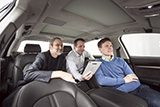Fraunhofer Prize for a project of Fraunhofer IIS: A concert hall for on the move
Erlangen/Wiesbaden, Germany, June 9, 2015: Optimum playback of digitized music requires superior software solutions. The Fraunhofer Institute for Integrated Circuits IIS has developed intelligent algorithms known as Cingo® and Symphoria® that produce a natural and immersive 3D audio experience. So you get to feel like you’re at a live concert – even when you’re actually listening on a mobile device or in the car.

People often listen to music in far from ideal conditions. For example, the quality of the speakers used in smartphones, tablets and headphones is not always the best, and the speaker positions and passenger compartment acoustics can cause difficulties in the automotive environment. But people still expect premium audio quality. The software solutions Cingo® and Symphoria® compensate for hardware weaknesses while simultaneously reproducing the musician’s intended sound image with the utmost precision – regardless of which speakers or headphones the listener is using.
“In a concert hall, the music doesn’t just come directly from the stage. We also hear the sound that bounces off the walls and ceiling. It’s the overall combination that gives us the impression of three-dimensional sound,” says Symphoria® project manager Oliver Hellmuth. Cingo® and Symphoria® analyze which elements of a recording are direct sound and which are reflected sound. They then join them together to create natural three-dimensional sound.
Close collaboration with sound engineers
However, it’s not enough to rely on signal analysis of the music to create an optimum listening experience using Cingo® on mobile devices and Symphoria® in vehicles. The key is to get engineers and sound technicians working together. “The engineers know how to develop the tool, and the sound technicians know how to make the best use of it,” explains Jan Plogsties, project manager for Cingo®. That’s why the sound technicians at Fraunhofer IIS were involved in making adjustments to the sound reproduction at an early stage in tandem with the technical analysis. Since no audio benchmark is available to judge the quality of these kinds of audio algorithms, the experts’ subjective opinions were crucial.
The IIS researchers have worked closely with their customers at every stage of the development process. That’s because the sound has to be tailored to the particular speakers of each individual device. “When a manufacturer chooses to implement our software, we configure the sound separately for each model. It’s a tuning process – and that’s why we need the expertise of our sound technicians,” says Oliver Hellmuth.
Right from the start, Cingo® and Symphoria® were developed with the idea of launching them as products. “We asked the same question we always ask ourselves: if it ends up working well, who could benefit from it? Our preliminary discussions soon revealed that a number of companies were very interested in good 3D surround sound solutions,” says Harald Popp, who is in charge of marketing the applications.
Since 2013 Google has included Cingo® in all its Nexus devices, and Samsung launched the software as part of its virtual reality glasses. Audi is using Symphoria to create 3D and surround sound effects in its TT, Q7 and R8 models. For the development and market launch of Cingo® and Symphoria®, Oliver Hellmuth, Jan Plogsties and Harald Popp are recipients of the 2015 Joseph von Fraunhofer Prize.